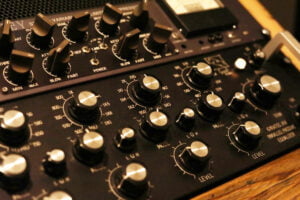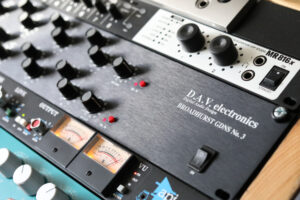The Avantone Mixcube is a modern reissue of the Auratone 5C. It’s a speaker designed to check how mixes will translate on cheap, mono playback systems – like a kitchen radio with poor FM signal. Just as the 5C was a common sight in studios back in its day, the Avantone Mixcube is now the industry standard for a ‘grotbox’ speaker. Although sometimes used in stereo, it’s more common to just see one; usually poorly placed on a desk or mixer bridge.
What does the Avantone Mixcube sound like?
The Avantone Mixcube sounds like the most expensive terrible speaker you’ll ever encounter. It has a steep roll-off around 80Hz, meaning it has very little low end. The highs are fairly cramped. It’s a very mid-rangey speaker.
But at the same time, it performs very well in that mid-range. Its transient response is surprisingly well-defined, offering a level of detail you don’t hear on actual cheap consumer speakers, that usually just turn music into sludge. So while it’s a highly frequency-restricted speaker that gives a good impression of how a mix will translate to radios, TVs, phones, and laptops, it still offers enough information for you to actually work with.
Why is the Avantone Mixcube useful?
The Avantone Mixcube is invaluable for a ‘real-world’ check. In the past, the Auratone 5C served to check how mixes would translate to radio, especially in mono. Nowadays, the Mixcube serves as a good proxy for built-in speakers on consumer devices like smartphones and laptops, as well as inexpensive earbuds with no bass response to speak of.
And the rise of Bluetooth speakers has made mono a more important factor to consider than it had been for a while. As such, it’s common practice to start a mix on a Mixcube, getting it to work on the little speaker in mono before working up to bigger speakers. That way you can make sure you don’t have any parts that won’t come across on a single output, or any bass that won’t translate on smaller playback systems.
History of the Avantone Mixcube
There’s a famous story of the Auratone 5C that the Mixcube is based on. It’s said that Quincy Jones mixed 80% of Michael Jackson’s Thriller on a single Auratone 5C placed on a bookshelf behind him. It’s impossible to say how much that may have contributed to its success (at one time the highest selling record in history). But it certainly can’t have hurt to prioritise how it sounded on radios and boomboxes.
In the same way, if you want something to sound good on smartphone speakers, get it sounding right on a Mixcube. It’ll still sound terrible on a phone, but it’ll sound less terrible than if you hadn’t.
Explore more equipment

Gyraf Gyratec XIV
The Gyraf Gyratec XIV mastering EQ is a parallel passive tube EQ with a warm, luscious tone. The perfect character complement to a cleaner main mastering EQ.

DAV Electronics BG3
The DAV Electronics BG3 mastering EQ is broad tone-shaping EQ made with the highest quality components. Based on the EQ used by Decca engineers in the 1970s.

Custom Audio Germany HDE-250
Essentially a Sontec-250 clone, the Custom Audio Germany HDE-250 main mastering EQ has become a modern classic in its own right.
